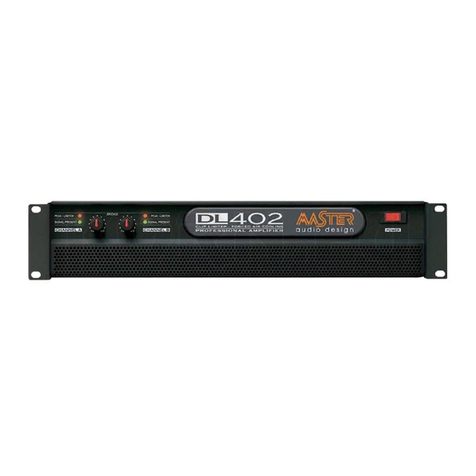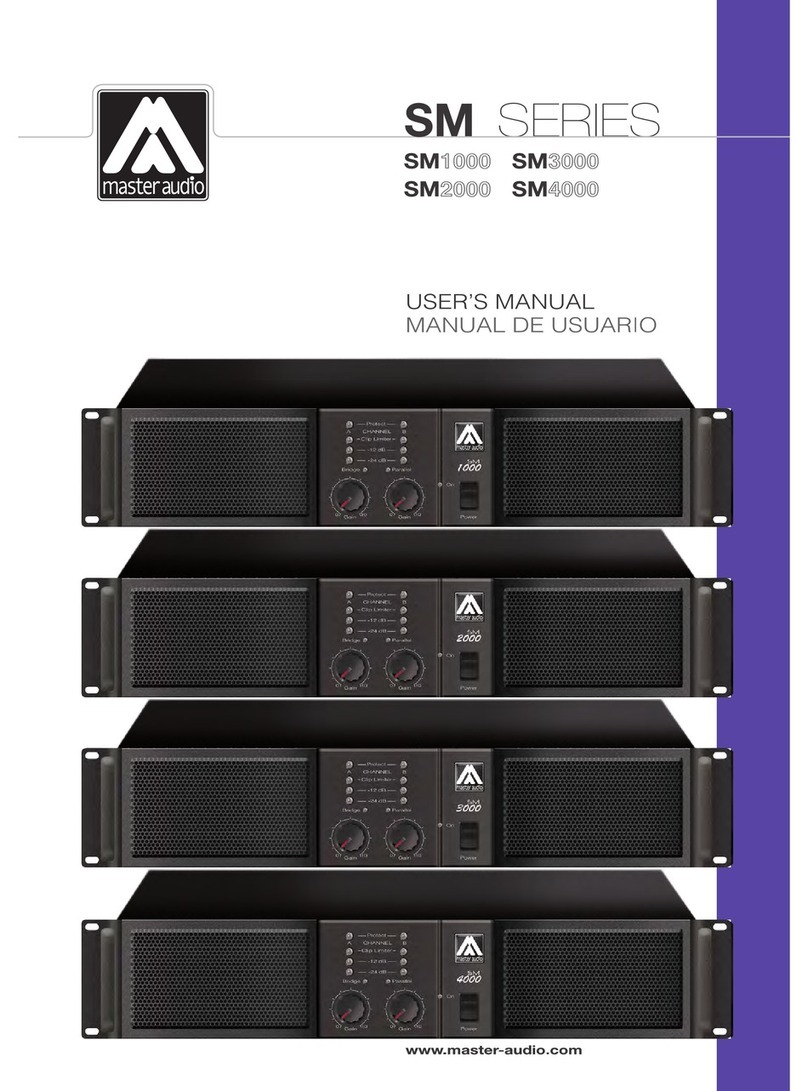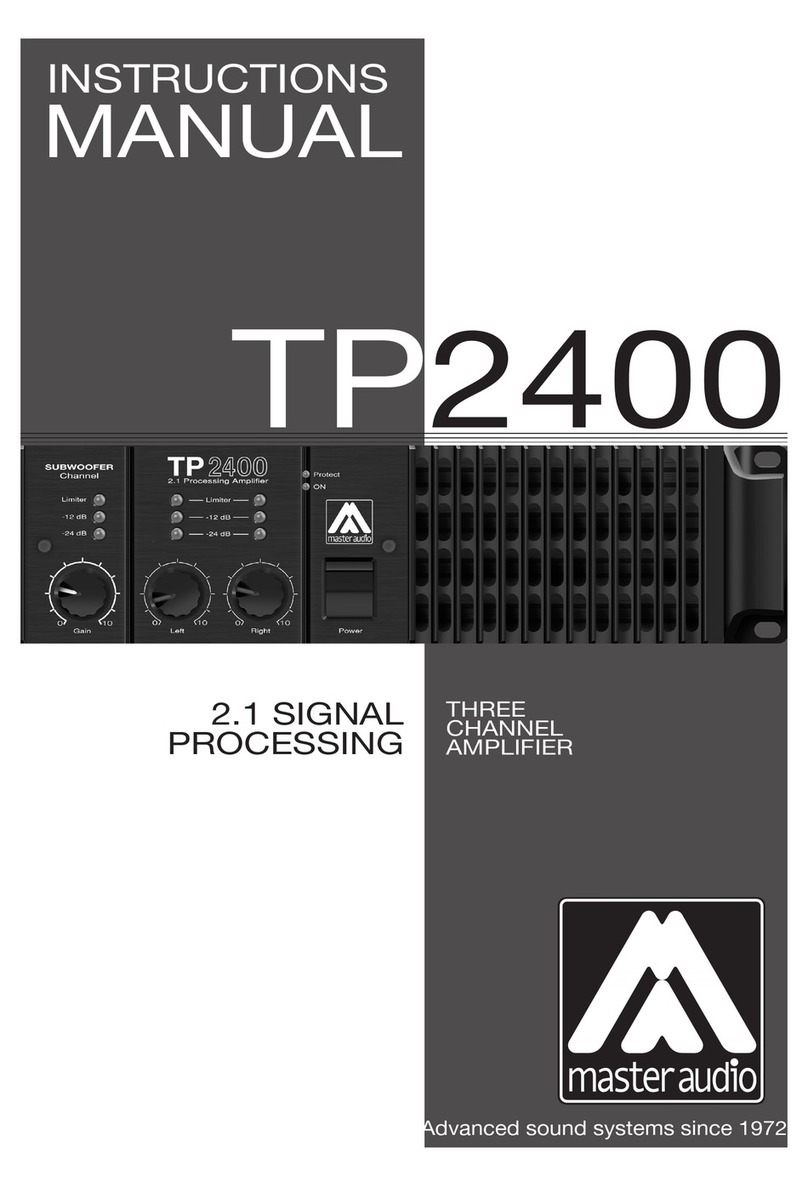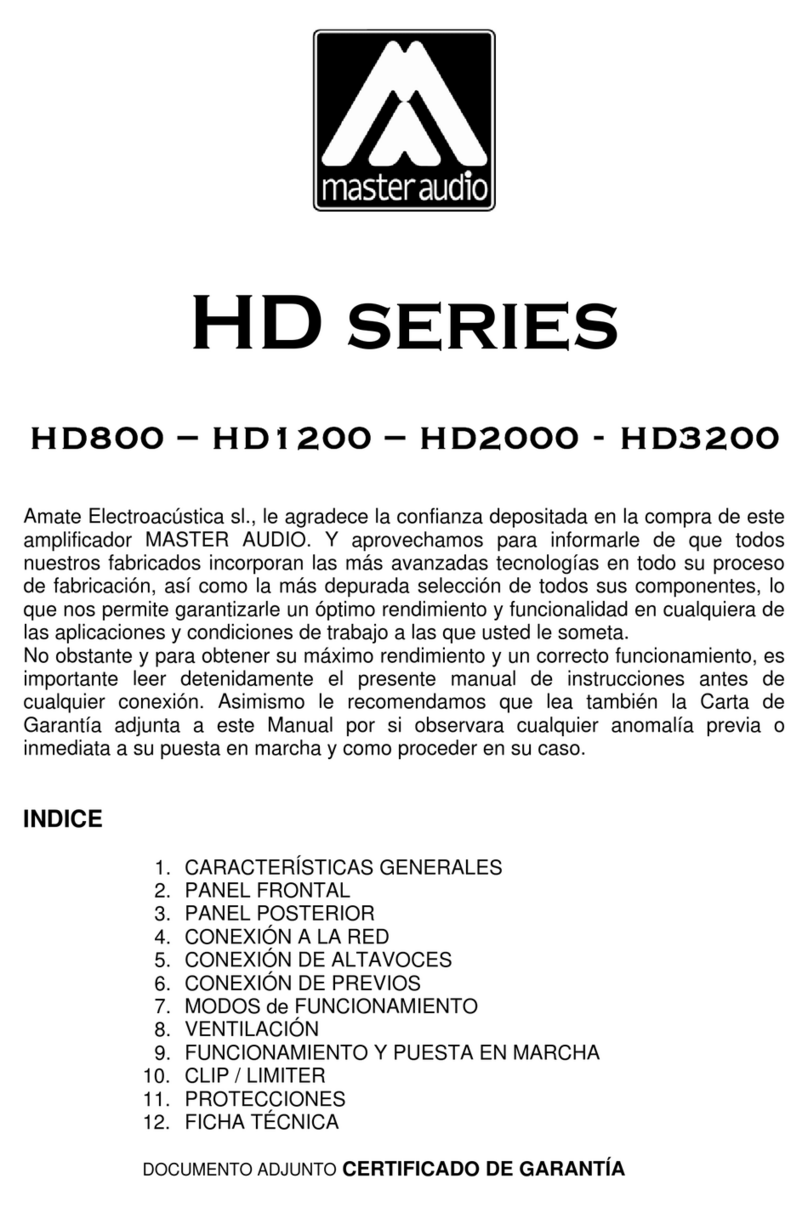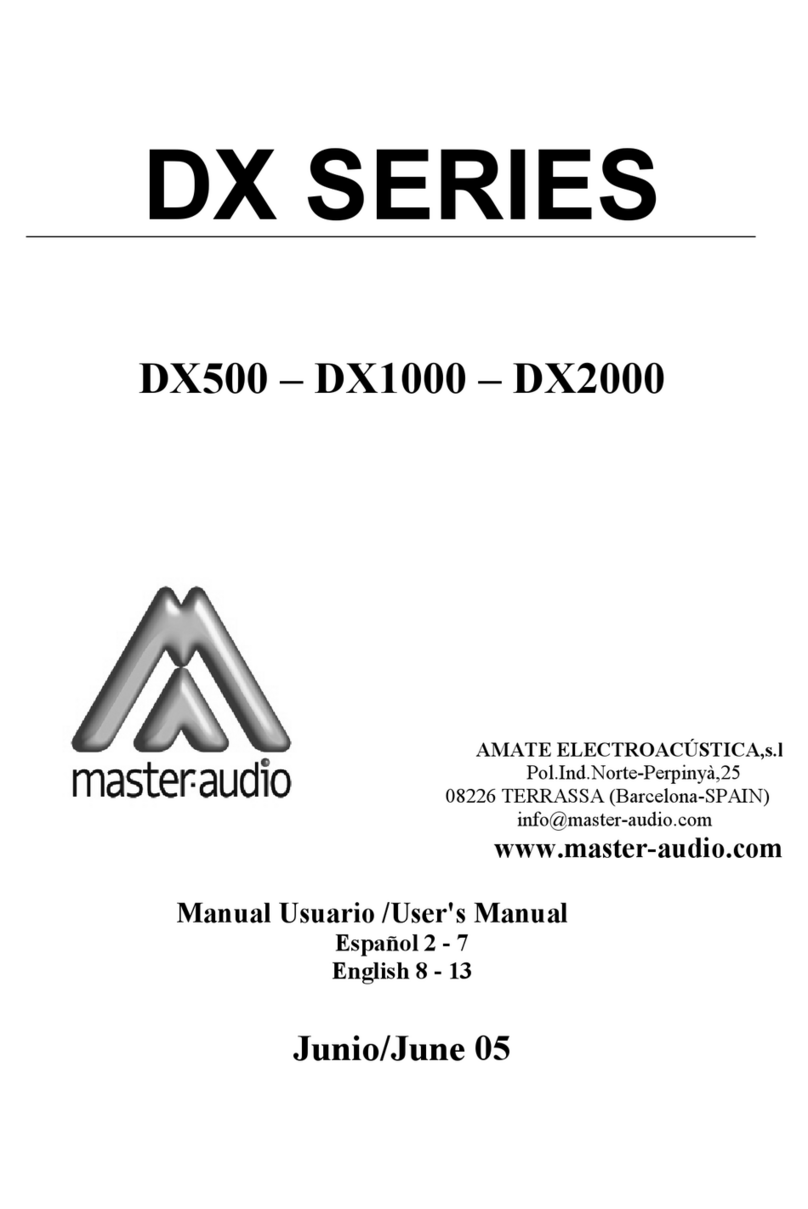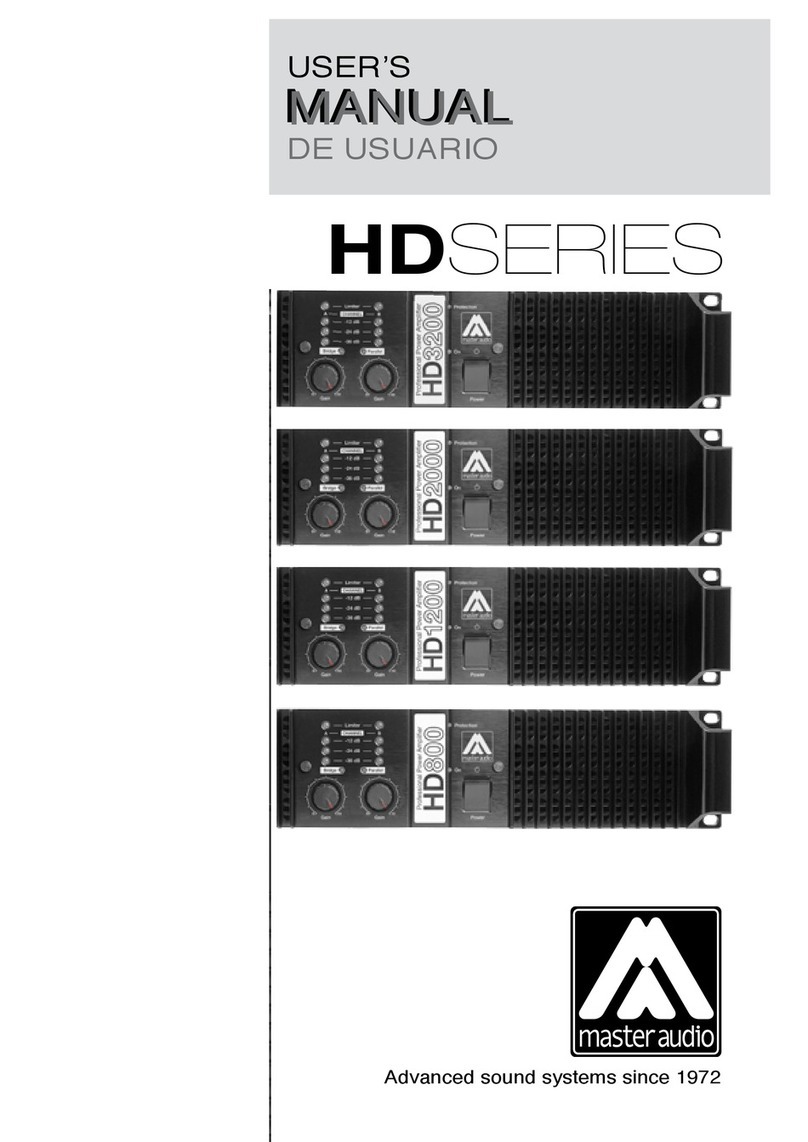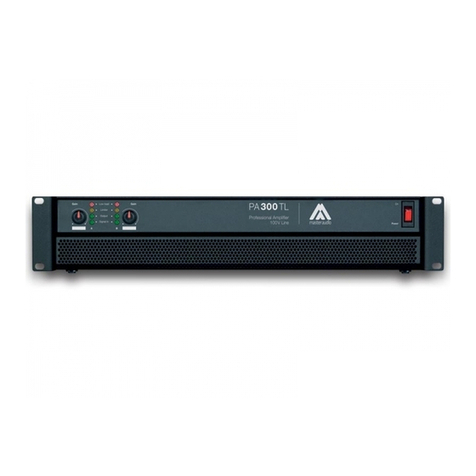14. Protections
Temperature
An inadequate installation or any other anomaly related to cooling may
cause that the amplifier’s temperature exceeds their safe limit (>90ºC),
exposing its internal components to failure. The temperature protection
would activate the corresponding limiters to reduce (balance) the output
power with the overtemperature, in order to keep the amplifier working
safely without undesirable stops. In case the temperature keep rising, the
corresponding protection circuit will cause a stop during a certain time
according to the seriousness of the anomaly detected. The PROTECTION
and LIMITER leds will light on at the same time, and the output of the
affected channel(s) will be disconnected.
In models HD2000 and HD3200, before the amplifier completely stops
because of temperature problems, it will reduce the output level by 6dB
approximately. Once the temperature reduce to normal parameters, the
normal output level will be reestablished.
Short circuit
In case of very low impedance or short circuit in any loudspeaker out-
put, the LIMITER led is activated and a significant descent of the output
level of the affected channel will be observed (loss of volume, but keeps
working).
Direct Current
In the case that due to some malfunction the power module tries to de-
liver direct current (DC) at the output, the protection circuit will imme-
diately disconnect the module to avoid damage to the loudspeakers. In
that case, the PROTECTION and LIMITER led’s will light on at the same
time and the output will be disconnected.
13. Limiter adjustment
The 2014 version HD amplifiers feature limiter adjustment, in which
the user, with an easy adjust, can limit the output power of each output
independently. It is an easy access adjustment and it is located behind
the front panel.
The front panel is fixed with two M4 screws with knurled head that
can be loosen with the fingertips. After removing the front panel you
will find two LIMITER sections, one per channel, they can be adjust with
a small flat-tip screwdriver.
BRIDGE:
In BRIDGE mode the limiter adjusment is the one for channel A, the
same with the volume adjust, see attached table of the delivered output
power depending on the limiter adjustment:
Note (1): The limiter adjustments and power that the amplifiers can deliver with
this adjustment are relative, because the HD amplifiers feature a dynamic limiting
system able to offers the best results.
The conditions to get the data from the tables has been created using 100 Hz
sineburst input signals with 100 ms at 0 dB and 400 ms at -20 dB. This condition is
considered as a standard / heavy duty in the Audio Industry.
STEREO PARALLEL:
In STEREO/PARALLEL mode each channel have an independent lim-
iter adjustment; see the attached table of the delivered output deppend-
ing of the limitrer adjustment:
OUTPUT POWER TO LIMITER SETTING
The factory setting for this parameter is set to fully clockwise, this
way the device delivers its maximum power with minimum distortion
thanks to its anti-clipping system.
Once the limiter settings have been adjusted, please attach again
the front panel with the two M4 screws with knurled head.
BRIDGE MODE 4 Ω HD800 HD1200 HD2000 HD3200
BRIDGE
MODE 4 Ω 1180 W 1640 W 2200W 4400W
STEREO/PARALLEL MODE
2 Ω HD800 HD1200 HD2000 HD3200
STEREO/
PARALLEL
MODE 2 Ω 590 W 820 W 1100 W 2200 W
LOW LOAD (BRIDGE 4 Ω or STEREO/PARALELL 2 Ω)
:
CAUTION: when you want to use the amplifier in bridge mode @ 4 Ω
or Stereo/parallel mode @ 2 Ω at full power it is recommended to set
the limiter in position 2 as shown in the attached table to avoid over-
heating. (Only HD4000 is ready to work on any position)
2
2
STEREO/PARALLEL MODE HD800 HD1200 HD2000 HD3200 HD4000
16 Ω 115 W 210 W 350 W 650 W 390 W
8 Ω 230 W 420 W 700 W 1300 W 750 W
4 Ω 450 W 800 W 1300 W 2400 W 1480 W
16 Ω 76 W 110 W 150 W 320 W 250 W
8 Ω 152 W 220 W 300 W 600 W 475 W
4 Ω 295 W 410 W 550 W 1100 W 975 W
16 Ω 50 W 70 W 90 W 180 W 180 W
8 Ω 100 W 140 W 180 W 320 W 375 W
4 Ω 195 W 280 W 350 W 625 W 725 W
16 Ω 25 W 38 W 50 W 100 W 95 W
8 Ω 50 W 76 W 100 W 200 W 190 W
4 Ω 95 W 135 W 200 W 400 W 380 W
0
2
3
6
BRIDGE MODE 8 Ω HD800 HD1200 HD2000 HD3200 HD4000
8 Ω 900 W 1600 W 2800 W 4800 W 2960 W
8 Ω 590 W 820 W 1100 W 2200 W 1950 W
8 Ω 390 W 540 W 700 W 1250 W 1450 W
8 Ω 190 W 270 W 400 W 800 W 760 W
0
2
3
6
